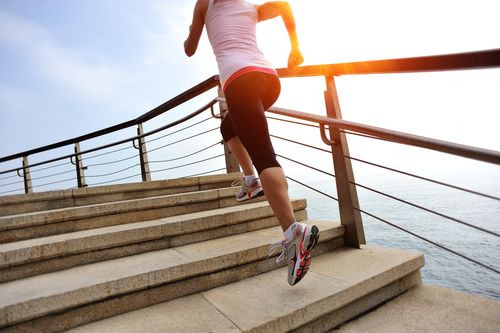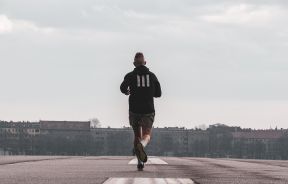Food For Runners: How Shalane Flanagan (And Other Pros) Fuel And Actually Stay Full While On The Run

If only Limp Bizkit had done it all for the cookie, then their song would have easily been an anthem for runners everywhere (this writer included). Sure, running is appealing for a number of reasons — it’s one of the top types of cardio, it involves a super cool community, and can be a form of therapy — but none more so than for the indulgent, well-deserved meals runners can treat themselves to after they’ve crushed crazy-high mileage.
The problem is when runners are running more miles than usual, and burning more calories, they get hungry. Like, hungry. This special, often insatiable feeling is also known as “runger” or feeling “rungry.” (It’s a real thing, guys. Trust us.) And when runger strikes, runners will reach for any and everything to get their stomach to quiet down. Unfortunately, running all the time doesn't mean you can eat whatever you want without consequence. A thought like that can actually lead to runners gaining weight. It's not unheard of.
Here's the thing: it’s possible for runners to fuel their bodies and feel full at the same time. While most of these foods are not one size fits all — the standing advice is for runners to spend some time searching for what truly works for them and their body — they are a great place to start. And who better to inspire runners than Boston Strong marathoner Shalane Flanagan? Or the editors of Runner’s World (RW)? How about the half marathon selfie queen Kelly Roberts? Exactly.
So Medical Daily (respectfully) stalked these pros and experts to get a better understanding of their runger, plus the foods they personally reach for to run their best race yet. Are you listening, soon-to-be New York City marathoners?
No Carb Left Behind
Brandon Mentore, a certified strength and conditioning coach and sports nutritionist, told Medical Daily in an e-mail that there’s a three-pronged approach to runger: endorphin fatigue (the hormone that helps to mask pain), low dopamine (a neurotransmitter that helps you feel good and focus), and depleted energy.
“When you layer all three parts together — pain, focus, and lack of energy — it produces the compounding ‘runger’ effect,” Mentore said. “It’s important to understand that your body can deal with the first two, dopamine and endorphin fatigue, but it’s the gaps in energy production that is the straw that breaks the camel’s back.”
Let's face it: Running is a demanding sport that consists of both great and bad days. The latter is when you can't get a hold of your runger and just feel like you're running on empty. Hence why carbohydrates are a main ingredient in every athlete's, running or not, diet. Carbs are the body's main source of fuel. They break down into simple sugars that get absorbed by the bloodstream, hence the term "blood sugar" or glucose, and get used up as energy.
Foods that combine carbs, protein, and fiber tend to be the ones runner's reach for. In addition to restoring energy, protein helps to build and repair the muscles and fiber is responsible for that full feeling. Building meals around these three ingredients are more often than not a winning strategy for fighting runger.
Again, every runner is different. There's no universal approach to getting a hold of hunger. But experimenting with ones that combine some of the aforementioned ingredients is an, ahem, step in the right direction.
Ready, Set…Fuel!
Now let’s get to why you’re really here, or the foods experts and runners have come to rely on to feel fresh and full.
Shalane Flanagan, American Long Distance Runner
Flanagan ran this year’s Boston Marathon in 2:22:02, the fastest any American woman has ever run the course. Though she came in seventh, she’s pretty much announced she’ll be back to chase that win again next year, and she told Medical Daily how she’ll use food to prepare.
“When I’m training for a marathon, I look at food as a vital component to my success,” she said. “I log anywhere from 100-120 miles a week, which is roughly 14-17 miles a day. Fueling appropriately before, during and after my sessions allows me to train longer and harder and stay all the more healthy for it. I emphasize a diet that optimizes performance, which to me means eating as clean as possible as well as taking in nutrient-dense foods.”
Flanagan’s typical day looks a little something like this: Coffee with creamer, and oatmeal with fruit and honey fixings for breakfast; a veggie-packed turkey sandwich on whole wheat bread or a large salad with leafy greens like kale, nuts, fruits, or grains, and protein, like chicken or steak for lunch; and more protein with veggies, like sweet potatoes and asparagus, and grains for dinner.
She likes to enjoy a side every now and again, like dark chocolate and tea with almond milk. The general takeaway is that the more nutrient-dense the food, the better. Flanagan's top choices all contain a healthy dose of vitamins, like omega-3 fatty acids, calcium, iron, and zinc, as well as energy from carbs and muscle-repairing protein.
Wondering about what she fuels with mid-run: sports drink and KIND snack bars. "Before, during, and after I workout (depending on the intensity or duration), I consume a sports drink to keep electrolytes and hydration up as well as KIND bars because of their natural ingredients (low sugar) and combination of carbohydrates, protein, and fiber."
The Editors of Runner’s World
One could say an issue of RW serves as a beacon for new and veteran runners. Each issue features endless informative insight to nutrition, performance, strength training, gear, and any and everything else runner's might find helpful, especially if they're looking for a great race to run.
Just recently, the magazine underwent a makeover. In the October issue's masthead, a handful of editor's fessed up to their favorite post-race indulgence, showing that after running so hard, it's perfectly OK to eat... hard? You know what we mean. Senior Editor Joanna Sayago Golub said, “Give me a medium-rare steak and a bottle of Cab — only after properly rehydrating, of course — and I’m one happy runner.”
Elizabeth Comeau, RW's women's editor, said, "A giant iced coffee and a bagel smeared with avocado," whereas Paul Collins, RW's associate publisher, goes straight for the Chipotle burrito. "Complex carbs, but it's an easy decision," he said.
You can check out other editor's answers when you pick up the October issue. Runners can also, and totally should, check out the RW Cookbook. It's an entire book of recipes that takes all the guesswork out of fuel. You're welcome.
Lauren Fleshman, Oiselle Athlete and Co-founder of Picky Bars
You might have heard of Oiselle (pronounced "wa-zell"), the Seattle-based women's running apparel brand named after the French word for bird, which recently rocked New York Fashion Week as well as headlines, when it signed with Olympic distance runner Kara Goucher. But in addition to Goucher, tons of women flock to the chance to run for Oiselle. Once such runner is Fleshman.
In 2006 and again in 2010, Fleshman won the 5,000 at the U.S. Outdoor Track and Field Championships, and she finished 12th in her marathon debut at the New York City Marathon in 2011. She also has a one-year-old son, Jude, with husband (also pro triathlete) Jesse Thomas, which means she and her family are no stranger to hunger.
When Fleshman's husband couldn't find an energy bar that satisfied his nutritional and training needs, Fleshman put her science and athletic degree from Stanford to use and co-founded Picky Bars, a performance, real-food bar that skips sketchy ingredients and is actually balanced for sport. Just note their slogan: "It's freaking science, dude." Here's what Fleshman told Medical Daily about her every day routine, from fuel to lots of lycra.
“My morning routine starts off with a baby alarm clock crying between 6 a.m. to 7 a.m," she said. "I prepare a French press of Backporch Daybreak, baby in arm, and then proceed to feed us oatmeal, fruit, and yogurt while it brews. My husband flies through the kitchen in matching lycra and goofs off with [our son] Jude and I before jetting off for a ride. At 8 a.m. our babysitter Jessica comes over and I get myself ready for work. I pick out the perfect workout outfit for that day's weather and physical challenge, pack my bag with water and Picky Bars for the team, and stretch on the living room floor while catching up on social media. At 9 a.m. my teammates from Oiselle Little Wing show up, we pile in one car and head out to a trail or track for training. By 11:30 a.m., I've already covered 10 to 12 miles, grab a picky bar and have the whole day ahead to work on writing and marketing projects.”
Picky eating for the win.
Christopher Heuisler, Westin Hotel's National Running Concierge
For starters, it's a question Heuisler, the sub-three-
Heuisler is an RRCA-certified coach who has been running for over 15 years, in addition to his decade-long stint as an actor and being a PR major from Penn State University. Serving as the Westin's first-ever running concierge was a way to combine all three of those things. When it comes to eating and training for a race, the hard-and-fast rule he follows is "everything in modertaion."
“I eat just about everything. I’m also the first to admit that I could certainly benefit from more vegetables," he told Medical Daily in an e-mail. "I try to keep my sugar intake low and revolve it around a workout. In other words, if I’m going for an 8-mile run, I’ll try to have a bagel and peanut butter about an hour and a half before I leave. The workout seems to benefit from that boost of carbs and sugar. And after every run, I always drink a tall glass of low-fat chocolate milk. On hot days, I look forward to that refreshment more than anything."
Nope, chocolate milk isn't just for kids. A number of studies continue to find the childhood drink has really great benefits for recovery, even improving training times and body compostion in athletes.
Post-race, Heuisler is all about that pasta with meat sauce and hopefully, as he said, a side of vegetables. For dinner, it's as simple as meat, vegetables and carbs.
Kelly Roberts, Runner and Blogger for RunSelfieRepeat.com
Fuel may be tough to get a handle on, but even tougher is getting your mind onboard with your body’s decision to power through anything more than a mile. For 13.1 miles, or a half marathon, it’s downright difficult; a struggle Roberts faced when she was getting ready to run this past spring's New York City half marathon. Her solution? Selfies with hot guys.
Roberts posted a picture of a hot guy at every mile of her race until she crossed the finish line, using the hashtag #HotGuysOfTheNYCHalf to document the whole thing on her instagram. And thank gosh she did, or how else would another precious human have been able to round them all up and post them to BuzzFeed?
So, maybe you shouldn't take a selfie while you run. You shouldn't do a lot of things when you run, but if it helps get you through, then by all means. Roberts is currently training for the New York City Marathon — one she told Medical Daily she anticipates on body-slamming — and like the pros before, she's looking to food to help her finish strong.
"Runger is a huge issue for me! I am always a hungry!" Roberts said. "What works best for me is eating a snack or a small meal every two to three hours. I reach for hummus or guacamole and pair it with pretzels or veggies like carrots, bell peppers, or celery. I eat a lot of salads, seasonal fruit, Peanut Butter Cookie LaraBars, Greek yogurt with honey and peanuts (sometimes I will add chocolate chips and get fancy), and I love edamame."
Roberts go-to meals? Burritos, salads, turkey or chicken sandwiches and, like Heuisler, pasta. And now that she's in the thick of her training, she's running over 40 miles a week. On long distance days, she's starting with green tea, a banana and a whole wheat bagel with peanut butter. Mid-run, it's either Strawberry Banana Gu, a popular liquid sports gel, or ENERGYbits, plus two Gatorades.
"During my entire long run, I look forward to a low-fat chocolate milk and it's the first thing I reach for when I finish," Roberts said. "After my chocolate milk, I find the nearest brunch spot for a giant veggie omelet with home fries. Yes, I'm completely drenched with sweat, but come on, I will do anything for a giant omelet. GI (gastrointestinal) trouble after my long run is quite common for me, so I normally drink a GTs Enlightened Synergy Organic and Raw Kombucha on my subway ride home."
Jake Schonfeld, Marketing Director of Blood, Sweat, Cheers
If you haven’t heard of BSC, fix that ASAP. This organization is on a mission to make fitness as fun and social as possible. CEO Jonathan Ages was first inspired to start BSC when he kept discovering all the fun fitness opportunities after they'd already happened. With BSC, runners, and literally anyone who can appreciate a super fun sweat session, can stay on top of what's out there.
For runners in particular, BSC partners with ASICS America to host a monthly run club. That's where Schonfeld comes in, BSC's resident hungry runner. Schonfeld helps organize the club and ends each run the same way, with pizza and beer.
“We serve pizza at our run club because, well, pizza is awesome,” Schonfeld told Medical Daily in an e-mail. “We also serve beer because a) it's actually great for recovery post-workout and b) who doesn't love beer?”
How about when Schonfeld isn’t running with the BSC club? “When I run in the mornings before work, I like to treat myself to coconut water. Or if I'm feeling really deserving, a protein coconut water from Coco Libre. They're delicious,” he said. “[And I’ll] typically fuel up with either a banana or Mojo Sweet & Salty bars from Cliff's.”
The bottom line: Taking some time to research the foods associated with better fuel, less runger, is worth it. And it's worth knowing these foods don't have to fall into a super healthy, miserable category. It's like Heuisler said: everything in moderation, including moderation. Well, that last bit is from Julia Child. Same difference.



























